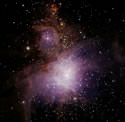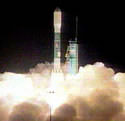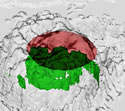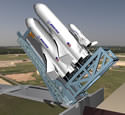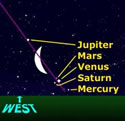
Image credit: NASA
The moon and five planets will appear close together in the night sky on Monday evening forming a rarely seen planetary conjunction. Look to the West, just after sunset. The planet Venus will be the brightest object in the sky, with Mars and Saturn below, and Jupiter above – Mercury will be visible just above the horizon, much dimmer than the rest. This will be the tightest conjunction of the planets in 40 years.
The Moon will join five visible planets to perform a seldom-seen celestial show on the evening of May 13.
To see the conjunction of the planets and moon, look in the western sky above the horizon just after sunset. Look for Venus, the brightest star in the group. Red Mars will be right below, and Jupiter, which appears white, will be topmost. Mercury is closest to the horizon, and Saturn is just below Mars.
“You’ll see just a sliver of the Moon, because it will be one day past new,” said Dr. E.M. Standish, an astronomer, also of JPL. “This will be the tightest conjunction for almost 40 years.”
A five-planet conjunction isn’t new; astronomers have been recording the phenomenon for over 3,500 years. Dr. Kevin Yau, an astronomer at NASA’s Jet Propulsion Laboratory, Pasadena, Calif., has studied ancient Chinese astronomy texts to find out more about the conjunction.
“The Han Dynasty came to power in 605 BC,” Yau said. “One year later astronomers saw a five-planet conjunction gathered in the constellation Dongjing – what we would call Gemini.” This led to the ancient Chinese belief that the conjunction was an omen of change, but the alignment really has no effect on Earth or Earthlings.
Based upon good observing circumstances, 40 five-planet conjunction events may [vcm2]have been seen between the years 2000 BC and AD 2000. The next time these bodies will be grouped so closely together will be in September 2040.
“This alignment is a great opportunity to see the planets, since they are so easy to find in the sky,” he said.
As part of the imperial establishment in ancient China, an astronomical observatory was usually built inside the capital city of the time. Trained astronomers were appointed to keep a diligent watch of the sky day and night. The Chinese constellations have names that represent palaces and gardens, generals and ministers.
“Today, we are grateful that such detailed observational records were kept,” Yau said. “Our modern astronomical database goes back about five hundred years, which is relatively short in terms of astronomical timescales.” Astronomers often need to access data covering a longer time span in order to prove or disprove their theories such as the effect of the 11-year solar cycle on the Earth’s climate change, or predictions of when a comet will be visible from Earth.
JPL is managed for NASA by the California Institute of Technology in Pasadena.
Original Source: NASA/JPL News Release

